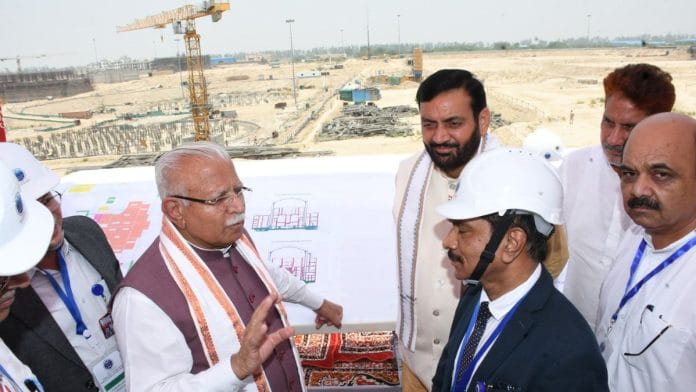Gurugram: The completion of northern India and Haryana’s first nuclear power plant, the Gorakhpur Haryana Anu Vidyut Pariyojana (GHAVP), has been pushed back again, with Union Power Minister Manohar Lal Khattar announcing that the first two of its four 700 megawatt units will now commence operations only in 2031.
This revised timeline marks a significant delay from the original target of 2020-21 and the more recent projection of 2028, highlighting the challenges plaguing this ambitious project.
Khattar told mediapersons Saturday that the 2,800-MW plant, comprising four 700-MW units, will be rolled out in two phases: 1,400 MW by 2031, and the remaining 1,400 MW by 2032. He attributed the delays to the sandy terrain and technical complexities, adding that nuclear power plants typically require 13 years to complete.
The announcement came during a visit by Khattar and Haryana Chief Minister Nayab Singh Saini to GHAVP, a flagship project of the Nuclear Power Corporation of India Limited, in Fatehabad district’s Gorakhpur Saturday.
“Today in Fatehabad, Haryana, along with Hon’ble Chief Minister Shri @NayabSainiBJP, I reviewed the progress of North India’s first nuclear power plant — the Gorakhpur Haryana Anu Vidyut Pariyojana (GHAVP),” Khattar posted on X following a meeting with senior NPCIL officials and a tour of the site.
“This ambitious project will not only meet the long-term energy needs of Haryana and North India, but will also strengthen India’s commitment to clean and sustainable energy solutions,” he added, underscoring its alignment with India’s net-zero emissions target by 2070.
The project cost, initially estimated at Rs 23,502 crore in 2014, has now escalated to Rs 42,000 crore. Haryana will receive 50 percent of the generated electricity, with the central government taking the rest. Rs 80 crore is being allocated for development works in nearby villages.
Also Read: Haryana govt cracks whip: 80 irrigation officials in soup over quality of concrete used in projects
A project mired in challenges
GHAVP, envisioned as a cornerstone of India’s nuclear energy ambitions, has faced a litany of hurdles since its inception. As of May 2023, ground improvement work was 74 percent complete, with critical components, like end shields and steam generators already on site, according to a state government review that projected operations by June 2028.
The latest delay pushes the timeline further, raising questions about the project’s execution amidst India’s pressing energy needs.
Jivendra Kumar Jain, project director, and H.K. Nigotia, Chief Engineer (Civil) of the project, did not respond to ThePrint’s phone calls.
Parveen Jora, Fatehabad district BJP president, who accompanied Khattar and Saini on the inspection of the project site, told ThePrint Saturday that Khattar discussed in minute details the progress of the project and the challenges they were facing.
“The officers told Khattar that the civil work up to the plinth level is a major task, as it has to be given enough strength. However, the local soil, being sandy, posed challenges before the engineers. The officers also told Khattar that the civil work up to the plinth level is complete now, and the progress of the work will gather speed now,” said Jora.
The concept of establishing a nuclear power plant in Gorakhpur village took shape in 1984, when the region fell under the Hisar district. Fatehabad emerged as a distinct district in July 1997, and Gorakhpur was deemed suitable for the project due to its low seismic activity and the feasibility of securing land through compensation.
The central government gave its preliminary nod for the 2,800-MW nuclear facility in October 2009, prompting Nuclear Power Corporation of India Limited (NPCIL) to set up a project office in Hisar by April 2010.
Acquiring land proved challenging. The government secured 1,313 acres from Gorakhpur and neighbouring Kajalheri villages, but faced strong resistance from local farmers.
The 2011 Fukushima nuclear disaster in Japan amplified these protests, drawing support from environmental activists and notable figures, like former Army Chief and Union Minister General (Retd) V. K. Singh—now the Governor of Mizoram—who raised concerns about safety and displacement.
The agitation persisted until late 2012, when a compensation package of Rs 46 lakh per acre was offered, resolving the farmers’ grievances.
NPCIL purchased 186 acres in Badopal village in 2011 for a residential complex to house its staff and Central Industrial Security Force personnel. Local opposition, citing threats to the blackbuck habitat, forced NPCIL to scrap this plan in June 2018.
Despite these obstacles, the project moved forward, with then Prime Minister Manmohan Singh laying the foundation stone on 13 January, 2014.
(Edited by Sugita Katyal)
Also Read: In Haryana, cops, lawyers & khaps unite to steer youth away from drugs, gangs & ‘donkey routes’






